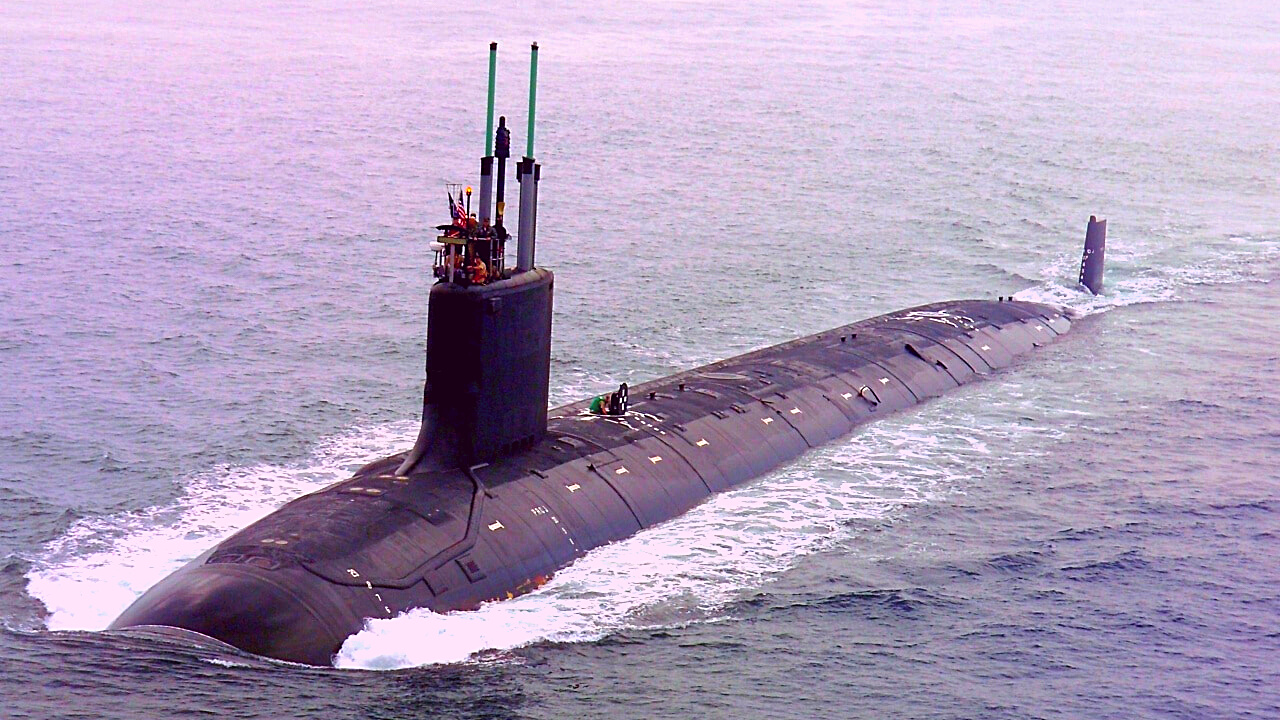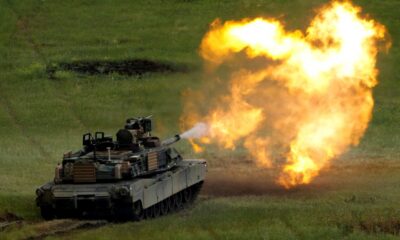
Technology
10 Biggest Submarines In The World
Submarines are fascinating machines that are capable of diving underwater as well as on the surface of water. Unlike ships that tumble with each passing wave, the submarines make their way swiftly and silently underwater.
These lean machines can stay submerged in water for weeks and even months together. Submarines played a major role during the first world war (1914-18) in naval warfare when Germany had employed them to destroy the merchant vessels on the surface. In those attacks, the submarines used an underwater missile known as a torpedo.
In World War II as well, these submarines played an important and larger role (1939-45) in both Atlantic (by Germany) and the Pacific (by the USA).
10. French Navy Triomphant-Class
Length: 453 feet
Type: Ballistic missile submarine
Surface displacement: 12,640 tonne
Submerged displacement: 14,335 tonne
Crew Capacity: Unknown
Max Depth: Over 400 meters
With a length of 453 feet, the French Navy Triomphant is the French Navy’s Force de dissuasuin, or strategic deterrent. This submarine was brought in to replace the 1971 redoubtable class.
When compared to other ballistic submarines, this one is rather small in size and has four boats on board. In comparison, the Soviet Typhoon class has six hulls and the American Ohio class has a hull force of 18!.
9. British Navy HMS Vanguard-Class
Length: 491 feet
Type: Fast battleship
Surface displacement: 44,500 long tons
Submerged displacement: 51,420 long tons
Crew Capacity: 300
Max Depth: 350 meters
The Vanguard-class of submarines forms the United Kingdom’s strategic nuclear deterrent force. There are four such submarines and each of them has been armed with Trident 2 D5 nuclear missiles. This submarine is powered by steam and the reactors convert the water into steam to drive the engines and generate electricity.
These submarines have been equipped with the world’s best sonar. Especially the ears are so sensitive that they can hear vessels from over 50 miles away. These submarines have a service life span of 30 years.
8. British Navy HMS Dreadnought-Class
Length: 504 feet
Type: Fast battleship
Surface displacement: 18,120 long tons
Submerged displacement: 20,730 long tons
Crew Capacity: 810
Max Depth: 150 meters
At 504 feet, the Dreadnought is UK’s nuclear deterrent that is hosted by the Vanguard-class submarine. This submarine has been specifically built to be a carrier for a nuclear-powered ballistic missiles. Besides, the design of this submarine has been incorporated from a selection of several British submarines.
This submarine will be ready to hit the seas by 2030s and therefore, details about it are currently scant. However, it has been revealed by the UK Defense Journal notes that this new line of submarines would have an increased autonomy, a cheaper sesnsor array and a common missile department.
7. Russian Navy Oscar II-Class
Length: 508.5 feet
Type: Nuclear cruise missile submarine
Surface displacement: 14,700 tonnes
Submerged displacement: 19,400 tonnes
Crew Capacity: 200
Max Depth: 154 meters
To provide safety from war ever breaking out, this class of submarines was designed by the Russian navy. The major threat was posed by the US carrier battle groups.
To provide a quiet propulsion, the hull of this submarine has been lengthened by 10 m. Besides, the electronic systems have been upgraded and the fin enlarged so the maneuverability can be improved.
In terms of displacement and length, these submarines are the third-largest ones in the world. In fact, only the Soviet Typhoon class and the American Ohio class are bigger than this submarine. Originally, the Oscar II class submarines were the largest attack submarines to have ever been constructed.
This submarine is equipped with 24 P-700 Granit supersonic anti-ship cruise missiles that have a range of 550 km.
6. Russian Navy Delta IV-Class
Length: 544 feet
Type: Fast battleship
Surface displacement: 7,800 tons
Submerged displacement: 10,000 tons
Crew Capacity: 135
Max Depth: 320 meters
After getting commissioned in 1987, this submarine spent two years undergoing repairs. The modernisation works on this submarine were part of a service life extension program at the Severodvinsk shipyard in northern Russia.
The upgrades in the Delta IV-class SSBN Tula (K-114) included electronic radio, sonar, and combat systems. This submarine completed all the post refit trials in 2017. There are seven such Delta IV class missile submarines that are currently being operated by the Russian Navy.
All of these seven submarines operate in the northeastern fleet and are based out of the Saida Guba Naval Base. These submarines were built between 1981 and 1992 and in Russia, they are referred as the deflin or 5. Russian Navy Borei-Class
Length: 557 feet A fourth-generation nuclear-powered missile submarine, the Borei class was originally designed to replace the old elta III and Typhoon class submarines and therefore become an important part of the Russian navy. Since the Soviet era, this was the first class of submarines to have ever been designed. It was initially named Project 935 and later changed to Project 995. It was also redesigned to make space for the new submarine-launched ballistic missile (SLBM) Bulava (SS-NX-30), in place of the abandoned R-39UTTH Bark missile. Length: 560 feet The US Navy makes use of the Ohio class submarines as virtually undetectable undersea launch platforms of intercontinental missiles. Between 1981 and 1997, 18 Ohio submarines were commissioned at the Electric Boat Division of General Dynamics based in Groton. The arms that are included in this submarine are four bow torpedo tubes and navy seals and marines. This class of submarines is being planned to be replaced by the future Columbia and Dreadnought SSBNs. Length: 561 feet est. The Columbia class submarines are the future of America’s nuclear deterrence. This submarine will be a replacement for the current Ohio class and will be much more cost-effective option over its 40-year lifecycle. Much unlike its predecessor, this submarine will never require refuelling during its entire duration of service. It will also have an electric-drive system which will reduce its audio signature and maintenance costs. It is expected that these submarines will hit the seas over the next decade. Length: 574 feet These submarines were created as a counter to the American Ohio-class submarines. They are known as the Typhoon-class in the West and as the 941 Akula (shark) to the Russians. Coloured red and black, they totally look like beasts. These vessels are supposed to carry huge amounts of nuclear-tipped ballistic missiles during the Cold war. These submarines are humongous 574 feet in length and 75 feet in breadth. Weighing a massive 25,000 tonnes, they are actually much bigger than the American vessels, for which they were originally created to compete with. These typhoon-class vessels are powered by two nuclear water reactors, two 50,000hp steam turbines and four 3,200KW turbo generators. It can sail at a speed of 22.2kt on the surface and 27kt underwater. These submarines have been designed in a unique way to make them survivable in case things go haywire during the Cold war. In such a case, they have been tasked with inflicting a nuclear apocalypse. Instead of carrying them behind, these submarines have a designated space to carry the huge missiles in the front sail part. Length: 604 feet This Russian beast, which is six hundred-foot-long submarine, can easily outshine the World War I battleship in displacing more water comparitively. It can easily dive to a depth of 1,700 feet. This Russian submarine was launched in the recent past (April 23, 2019), at the Sevmash shipyards in Russia. It was reported that Russian president Vladmir Putin watched the entire proceedings live via satellite. It is designed to support and be an useful asset in variety of military missions. Meanwhile, it is said to be the largest operating sub by any other naval force, including the U.S. Navy. Originally this sub was an Oscar II-class cruise missile submarine and officially it was known as Project-09852. However, the Russian government once ran of funds to complete it. Belgorod is like mother to other undersea vessels. It is neither an attack submarine nor a ballistic sub-missile. However, it can carry a payload on its back and a Losharik class mini-submarine can attach and detach to the bottom of the hull.
Type: Ballistic missile submarine
Surface displacement: 14,488 long tons
Submerged displacement: 23,621 long tons
Crew Capacity: 107
Max Depth: 950 meters4. US Navy Ohio-Class
Type: SSBN/ SSGN
Surface displacement: 16,499 long tons
Submerged displacement: 18,450 long tons
Crew Capacity: 140
Max Depth: 240 meters3. US Navy Columbia-Class
Type: Ballistic missile submarine
Surface displacement: 18,499 long tons
Submerged displacement: 20,810 long tons
Crew Capacity: 155
Max Depth: 300 meters2. Russian Navy Typhoon-Class Akula
Type: Ballistic missile submarine
Surface displacement: 24,500 tonnes
Submerged displacement: 48,000 tonnes
Crew Capacity: 160
Max Depth: 900 meters1. Russian Oscar-II Class Belgorod
Type: Nuclear cruise missile submarine
Surface displacement: 14,700 tonnes
Submerged displacement: 19,400 tonnes
Crew Capacity: 107
Max Depth: 600 meters
Trisha Katyayan is an experienced journalist who has print-media background and loves to research, organize and curate factual information in a presentable way.












